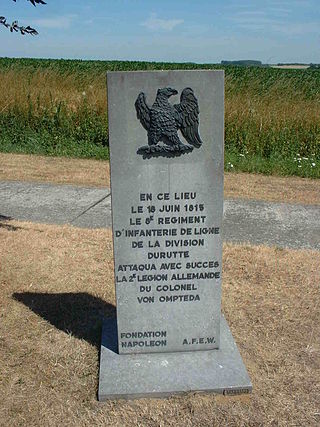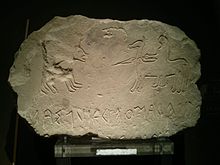
Marche, in English sometimes referred to as the Marches, is one of the twenty regions of Italy. The region is located in the central area of the country, and has a population of about 1.5 million people, being the thirteenth largest region in the country by number of inhabitants. The region's capital and largest city is Ancona.
The Moabite language, also known as the Moabite dialect, is an extinct sub-language or dialect of the Canaanite languages, themselves a branch of Northwest Semitic languages, formerly spoken in the region described in the Bible as Moab in the early 1st millennium BC.

Messapic is an extinct Indo-European Paleo-Balkanic language of the southeastern Italian Peninsula, once spoken in Salento by the Iapygian peoples of the region: the Calabri and Salentini, the Peucetians and the Daunians. Messapic was the pre-Roman, non-Italic language of Apulia. It has been preserved in about 600 inscriptions written in an alphabet derived from a Western Greek model and dating from the mid-6th to at least the 2nd century BC, when it went extinct following the Roman conquest of the region.

Venetic is an extinct Indo-European language, usually classified into the Italic subgroup, that was spoken by the Veneti people in ancient times in northeast Italy and part of modern Slovenia, between the Po Delta and the southern fringe of the Alps, associated with the Este culture.

A stele, or occasionally stela when derived from Latin, is a stone or wooden slab, generally taller than it is wide, erected in the ancient world as a monument. The surface of the stele often has text, ornamentation, or both. These may be inscribed, carved in relief, or painted.

The Etruscan alphabet was the alphabet used by the Etruscans, an ancient civilization of central and northern Italy, to write their language, from about 700 BC to sometime around 100 AD.

The province of Pesaro and Urbino is a province in the Marche region of Italy. Its capital is the city of Pesaro. It also borders the state of San Marino. The province is surrounded by San Marino and Emilia Romagna in the north, Umbria and Tuscany in the west, Ancona in the south and the Adriatic Sea on the east. The province has an enclave of the Umbrian commune of Citta' di Castello named Monte Ruperto. The province is also known as "Riviera of Hills". It is mostly covered by hills and is popular for its beaches.

The Osco-Umbrian, Sabellic or Sabellian languages are an extinct group of Italic languages, the Indo-European languages that were spoken in Central and Southern Italy by the Osco-Umbrians before being replaced by Latin, as the power of Ancient Rome expanded. Their written attestations developed from the middle of the 1st millennium BC to the early centuries of the 1st millennium AD. The languages are known almost exclusively from inscriptions, principally of Oscan and Umbrian, but there are also some Osco-Umbrian loanwords in Latin. Besides the two major branches of Oscan and Umbrian, South Picene may represent a third branch of Sabellic. The whole linguistic Sabellic area, however, might be considered a dialect continuum. Paucity of evidence from most of the "minor dialects" contributes to the difficulty of making these determinations.

Picenum was a region of ancient Italy. The name was assigned by the Romans, who conquered and incorporated it into the Roman Republic. Picenum became Regio V in the Augustan territorial organisation of Roman Italy. It is now in Marche and the northern part of Abruzzo.

The Liburnians or Liburni were an ancient tribe inhabiting the district called Liburnia, a coastal region of the northeastern Adriatic between the rivers Arsia (Raša) and Titius (Krka) in what is now Croatia. According to Strabo's Geographica, they populated Kerkyra until shortly after the Corinthians settled the island, c. 730 BC.

Sodasa was an Indo-Scythian Northern Satrap and ruler of Mathura during the later part of the 1st century BCE or the early part of 1st century CE. He was the son of Rajuvula, the Great Satrap of the region from Taxila to Mathura. He is mentioned in the Mathura lion capital.

South Picene is an extinct Italic language belonging to the Sabellic subfamily. It is apparently unrelated to the North Picene language, which is not understood and therefore unclassified. South Picene texts were at first relatively inscrutable even though some words were clearly Indo-European. The discovery in 1983 that two of the apparently redundant punctuation marks were in reality simplified letters led to an incremental improvement in their understanding and a first translation in 1985. Difficulties remain. It may represent a third branch of Sabellic, along with Oscan and Umbrian, or the whole Sabellic linguistic area may be best regarded as a linguistic continuum. The paucity of evidence from most of the 'minor dialects' contributes to these difficulties.

The Punic religion, Carthaginian religion, or Western Phoenician religion in the western Mediterranean was a direct continuation of the Phoenician variety of the polytheistic ancient Canaanite religion. However, significant local differences developed over the centuries following the foundation of Carthage and other Punic communities elsewhere in North Africa, southern Spain, Sardinia, western Sicily, and Malta from the ninth century BC onward. After the conquest of these regions by the Roman Republic in the third and second centuries BC, Punic religious practices continued, surviving until the fourth century AD in some cases. As with most cultures of the ancient Mediterranean, Punic religion suffused their society and there was no stark distinction between religious and secular spheres. Sources on Punic religion are poor. There are no surviving literary sources and Punic religion is primarily reconstructed from inscriptions and archaeological evidence. An important sacred space in Punic religion appears to have been the large open air sanctuaries known as tophets in modern scholarship, in which urns containing the cremated bones of infants and animals were buried. There is a long-running scholarly debate about whether child sacrifice occurred at these locations, as suggested by Greco-Roman and biblical sources.
A liburna was a type of small galley used for raiding and patrols. It was originally used by the Liburnians, a pirate tribe from Dalmatia, and later used by the Roman navy.

The Sfire or Sefire steles are three 8th-century BCE basalt stelae containing Aramaic inscriptions discovered near Al-Safirah ("Sfire") near Aleppo, Syria. The Sefire treaty inscriptions are the three inscriptions on the steles; they are known as KAI 222-224. A fourth stele, possibly from Sfire, is known as KAI 227.

The Picentes or Piceni or Picentini were an ancient Italic people who lived from the 9th to the 3rd century BC in the area between the Foglia and Aterno rivers, bordered to the west by the Apennines and to the east by the Adriatic coast. Their territory, known as Picenum, therefore included all of today's Marche and the northern part of Abruzzo.

The Daunians were an Iapygian tribe that inhabited northern Apulia in classical antiquity. Two other Iapygian tribes, the Peucetians and the Messapians, inhabited central and southern Apulia respectively. All three tribes spoke the Messapic language, but had developed separate archaeological cultures by the seventh century BC.

The Veliisa Stele is a fragment of a Luwian hieroglyphic inscription of Neo-Hittite date. It is on display in the Niğde Archaeological Museum, where its inventory number is 53.

Siculian is an extinct Indo-European language spoken in central and eastern Sicily by the Sicels. It is attested in less than thirty inscriptions from the late 6th century to 4th century BCE, and in around twenty-five glosses from ancient writers.











